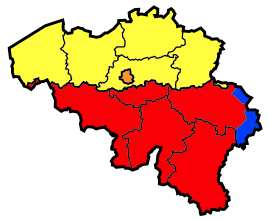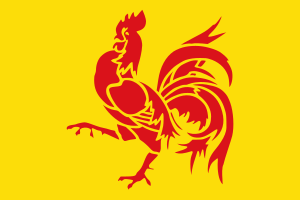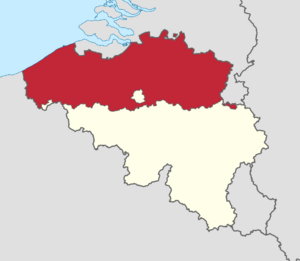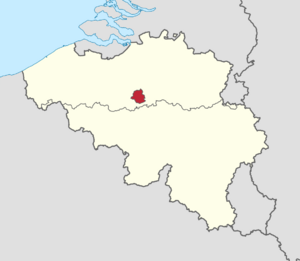Communities, regions, and language areas of Belgium facts for kids

| Dutch-speaking | French-speaking | |
| German-speaking | Bilingual FR/NL | |
| Community: | Region: | |
| Flemish | Flanders | |
| French and Flemish | Brussels | |
| French | Wallonia | |
| German-speaking | Wallonia |
Belgium is a country in Europe that shares its power between different levels of government. It's like a team where different players have different jobs. Belgium is split into three main parts: three communities, three regions, and four language areas. These parts all overlap, meaning they cover the whole country together.
This way of organizing Belgium started in 1963 and was added to the Belgian Constitution in 1970. Over the years, Belgium changed from a single, central government to a system where power is shared. This was done to help reduce disagreements between people who speak different languages and have different cultures.
Contents
How Belgium is Organized
Belgium's government system has several layers, like a cake! Each layer has its own parliament (where laws are made) and government (who carry out the laws).
- The Federal State is the main government for all of Belgium.
- There are four Language Areas. These areas simply show which language is official in different parts of the country. They don't have their own governments.
- There are three Communities. These deal with things like culture and education.
- There are three Regions. These handle things like the economy and public works.
- Below the regions are 10 Provinces.
- And finally, there are 581 Municipalities (cities and towns).
The Flemish Region doesn't have its own separate government. Instead, its powers are handled by the Flemish Community's government. This means Flanders has one government that does both regional and community jobs.
Belgium's Main Divisions
Belgium has three main Communities:
- The Flemish Community (Dutch-speaking)
- The French Community
- The German-speaking Community
And three main Regions:
- The Brussels-Capital Region
- The Flemish Region (Flanders)
- The Walloon Region (Wallonia)
There are also four Language Areas, which show where each language is official:
- The Dutch language area
- The French language area
- The German language area
- The bilingual Brussels-Capital area (where both Dutch and French are official)
These language areas don't have their own governments or powers. They just define where the different communities and regions can use their powers. For example, the Flemish Community has power in the Dutch language area and the bilingual Brussels-Capital area. The French Community has power in the French language area and the Brussels-Capital Region. The German-speaking Community has power in its own small German language area, which is part of the Walloon Region.
Some towns, especially near language borders, have "language facilities." This means people there can ask for some public services in a language different from the main official language of that area.
When the Communities and Regions were first set up, Flemish politicians decided to combine the Flemish Region and the Flemish Community. This means they have one parliament and one government for both. So, in the Dutch language area, one government handles almost everything except federal matters and local town issues.
The Walloon Region and the French Community have separate parliaments and governments. However, many members of the French Community's parliament also come from the Walloon Parliament or the Brussels-Capital Region's Parliament. Also, ministers in the Walloon Government often serve as ministers in the French Community's Government.
Smaller Divisions
The Flemish and Walloon Regions are each divided into five provinces. The Brussels-Capital Region is not part of any province and doesn't have any provinces within it.
These regions are then divided into 581 municipalities (cities and towns). Many municipalities used to be smaller, independent towns, but they merged over time.
There are also other smaller divisions, like administrative and judicial districts, and police zones.
What Each Government Level Does
Each level of government in Belgium has specific jobs:
- The Federal State (the main government) handles big national issues. This includes justice, defense (the army), federal police, social security, and national finances. It also deals with nuclear energy and state-owned companies like the Belgian Railways. The Federal State is also responsible for Belgium's agreements with the European Union and NATO. It has a say in public health and foreign affairs.
- The Communities focus on things related to people and their language. This includes:
* Culture (like TV, radio, and arts) * Education * The use of their specific language * Health policy (like hospitals and preventing diseases) * Help for individuals (like youth protection, social welfare, and help for families)
- The Regions deal with matters related to their specific land and area. This includes:
* Economy and jobs * Agriculture * Water policy * Housing * Public works (like roads and buildings) * Energy and transport * The environment and nature protection * Town planning * Credit and foreign trade They also oversee the provinces and municipalities.
Sometimes, different levels of government share responsibilities. For example, on education, the communities decide many things, but the federal government sets basic rules like how long school must be and what's needed to get a diploma. All levels can also be involved in scientific research and international relations related to their own powers.
Communities in Detail
| Name | Flemish Community | French Community | German-speaking Community |
|---|---|---|---|
| Location | |||
| Flag | |||
| Capital | Brussels | Brussels | Eupen |
| Population | About 6.9 million (60% of Belgium) |
About 4.5 million (40% of Belgium) |
79,479 (2024) (0.7% of Belgium) |
The Communities were first created in 1970 to handle cultural matters. In 1980, they gained more power from the federal government.
Both the Flemish and French Communities have power over the Brussels-Capital Region. This means they don't have a fixed number of people living only under their authority. The German-speaking Community is the only one that has its own specific area where it has sole power. This area is located within the Walloon Region.
Regions in Detail
| Region | Flemish Region | Walloon Region | Brussels-Capital Region |
|---|---|---|---|
| Location | |||
| Flag | |||
| Capital / Seat | Brussels | Namur | Brussels |
| Area | 13,626 square kilometers (44.4% of Belgium) |
16,901 square kilometers (55.1% of Belgium) |
162 square kilometers (0.5% of Belgium) |
| Provinces | none | ||
| Municipalities | 300 | 262 | 19 |
| Population [1 January 2024] |
6,821,770 (58.0% of Belgium) |
3,692,283 (31.4% of Belgium) |
1,249,597 (10.6% of Belgium) |
Flemish Region
The Flemish Region, also called Flanders, is in the northern part of Belgium. It covers about 44% of the country. It has 5 provinces and 300 municipalities.
The official language in Flanders is Dutch. However, in some specific towns near Brussels or the Walloon Region, French can be used for certain official tasks.
As mentioned, the Flemish Region doesn't have its own separate government. Its powers are handled by the Flemish Community's government, which is based in Brussels. Even though Brussels is not part of the Flemish Region, it serves as its government seat.
The five provinces in Flanders are: West Flanders, East Flanders, Antwerp, Flemish Brabant, and Limburg.
Brussels-Capital Region
The Brussels-Capital Region is right in the middle of Belgium. It's completely surrounded by the Flemish Region. It's the smallest of the three regions, covering only about 0.5% of Belgium. It includes the City of Brussels, which is the capital of Belgium, and 18 other municipalities.
Both Dutch and French are official languages in Brussels. Most people in Brussels speak French at home, but many also speak Dutch.
Within Brussels, both the Flemish and French Communities have their own special groups that help manage public services for their language speakers. There's also a group that handles matters for both communities.
Since 1995, the Brussels Region is not part of any province. Its regional government and community groups handle most of the jobs that provinces usually do.
Walloon Region
The Walloon Region, also called Wallonia, is in the southern part of Belgium. It covers about 55% of the country. It has 5 provinces and 262 municipalities. Its capital city is Namur.
The official language in Wallonia is French. However, in nine eastern municipalities near the German border, German is also an official language. In some towns near Flanders, Dutch can be used for administrative purposes.
The five provinces in Wallonia are: Hainaut, Walloon Brabant, Namur, Liège, and Luxembourg.
See also
- Language legislation in Belgium
- Municipalities with language facilities











